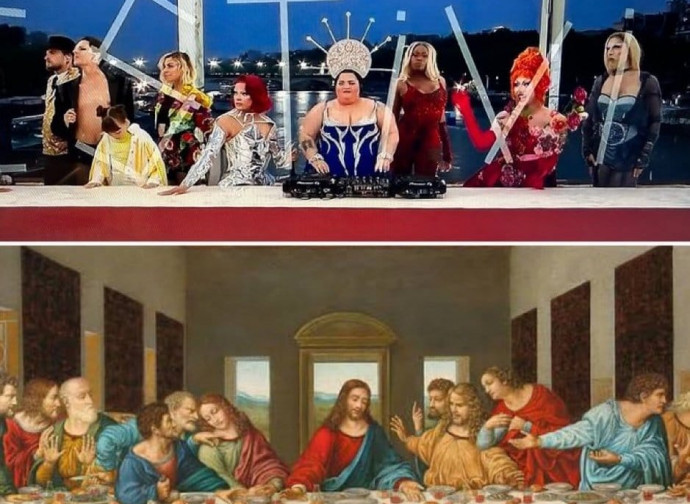Yes, the one at the Games was a parody of the Last Supper
The blasphemous ‘Last Supper’ at the opening ceremony of the Olympics, gives rise to a counter attack starting with the denial of any association with Leonardo's masterpiece. But the arrangement of the characters, even with the inclusion of Dionysus, is manifest. And the reference to van Bijlert is a home goal...

Besides being vilified, there’s an accusation (in vain) of ignorance to contend with: Christians, we are told, have a persecution complex, because the disputed Olympic pantomime did not depict the Last Supper, but the Feast of the Gods.
The proof, it seems, is in the iconographic reference to Jan van Bijlert's work of the same name. But, even if it were, in the post-Christ era - and especially after Leonardo Da Vinci - an image of a table where there is a central character and the others arranged on the same side evokes in the common imagination Christ at the Last Supper, not some pagan divinity. Also the minimalist architectural scansion recalls Leonardo's famous painting in stylised form. Therefore, the desired and predictable result was precisely that of a parody of the Last Supper, whatever the alleged iconographic sources might be ex post in support of the most discussed scene of the Festivité at the opening ceremony of the Olympics involving twelve including drag queens.
The fact that the claimed source relies on the iconography of the Last Supper apparently doesn’t count. The website of the Magnin Museum in Dijon, which houses van Bijlert's work clearly states that it is indeed a Christian subject in mythological disguise: ‘In the context of the Reformation, during which church commissions had disappeared, the artist found a stratagem to paint a Christic Last Supper under the guise of a mythological subject’. Moreover, if one wished, there would have been many other ways to depict the ‘Feast of the Gods’ and the ‘table’ is the one least used. For example, the one painted by the three artists Giovanni Bellini, Dosso Dossi and Titian Vecellio, is more akin to a courtly picnic (the term is used, just to stress the different ways the theme and characters can be depicted). Yet, to ‘justify’ the Olympic vilification, the very example that most recalls Leonardo's (and Christian) Supper is the one used.
The organising committee offered ‘its apologies if anyone felt offended’. A sign that evidently, even if one wants to salvage any subjective intentions, the offence was objectively justified. In fact, it only requires putting the two images - Leonardo's and Van Bijlert's (see below) - side by side to verify which is the more immediate visual reference to the Olympic ‘staging’. "Obviously, our intention was not to disrespect a religious group, whatever that may be. On the contrary, our intention was to show tolerance and communion,' says the 2024 Olympics communication director, Anne Descamps. That idea of respect, tolerance and communion was even more clearly visible in the macabre depiction of Marie-Antoinette decapitated (in the chapter Liberté), and precisely at the Conciergerie, where the queen was imprisoned awaiting execution, but ‘I didn't want to glorify the guillotine,’ says artistic director Thomas Jolly. So having verified the unreliability of the excuses and alleged good intentions, let’s return to the matter of the staging.
‘No, the Supper was not my inspiration,’ says Jolly, who does not even mention the Pagan Feast painted by van Bijlert called into question on social media by his supporters. Rather he retorts that it cannot be the Last Supper because ‘there is Dionysus coming to the table’ and plays on the Olympus-Olympics assonance. But who is trying to hoodwink, the fact that the singer Philippe Katerine painted blue sat at that table, in the role of Dionysus, does not exclude the reference to a dinner at all, indeed he was the ‘main course’ served under the enormous cloche. It is also hard not to think that the large woman with the bizarre headdress placed in the centre embodied some parody of the priestly role. But even if we were to take the pagan inspiration at face value, in the remote hypothesis that among the spectators was a worshipper of the ‘false and lying gods’ (in Dante's words), shouldn't they, in turn, feel vilified by this sort of Olympian mockery?
Jolly's main argument, like that of the committee, is the usual all-inclusive blah-blah-blah: ‘I didn't want to be subversive or shock anyone. Quite simply, in France we have the right to love each other, how we want and with whom we want, we have the right to believe or not to believe. Last night [Friday 26 July, ed.], we simply put on a show of republican ideas, of benevolence and inclusion'.
This is exactly what one sees at the so-called gay prides, where a certain ‘inclusive’ world (which is all the rage at these Olympics...) talks about respect for all, while staging systematic offences to Christianity. But one knows that the rainbow justifies the means.
As for poor Marie-Antoinette, the famous phrase that she never actually uttered (‘If they have no more bread, let them eat cake’) should rather be attributed to Macron: if the people are tense, afraid of attacks, in the grip of insecurity, let them enjoy this drag show.



